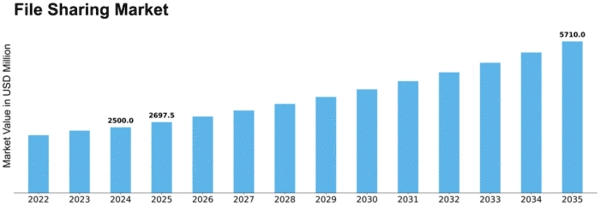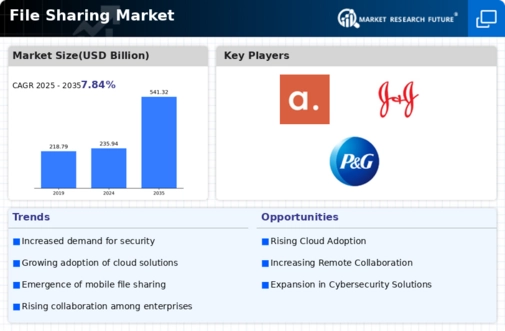-
EXECUTIVE SUMMARY
-
MARKET ATTRACTIVENESS ANALYSIS 28
-
MARKET INTRODUCTION
-
DEFINITION 29
-
SCOPE OF THE STUDY 29
-
RESEARCH OBJECTIVE 29
-
MARKET STRUCTURE 30
-
RESEARCH METHODOLOGY
-
MARKET DYNAMICS
-
INTRODUCTION 38
-
DRIVERS 39
- ADVANCEMENTS IN DIGITAL TECHNOLOGY 39
- INCREASING ADOPTION OF BYOD 39
- DRIVERS IMPACT ANALYSIS 39
-
RESTRAINT 40
- CONCERNS REGARDING DATA SECURITY 40
- RESTRAINT IMPACT ANALYSIS 40
-
OPPORTUNITY 41
- INCREASING ADOPTION OF CLOUD-BASED SERVICES 41
-
IMPACT OF COVID-19 ON FILE SHARING MARKET 41
-
MARKET FACTOR ANALYSIS
-
VALUE CHAIN ANALYSIS 42
- VENDORS/SERVICE PROVIDERS 42
- SYSTEM INTEGRATORS 42
- END USERS 42
-
PORTER’S FIVE FORCES MODEL 43
- THREAT OF NEW ENTRANTS 43
- BARGAINING POWER OF SUPPLIERS 44
- THREAT OF SUBSTITUTES 44
- BARGAINING POWER OF BUYERS 44
- INTENSITY OF RIVALRY 44
-
GLOBAL FILE SHARING MARKET, BY TYPE
-
OVERVIEW 45
-
SYSTEM NATIVE 45
-
CLIENT SERVER 45
-
PEER-TO-PEER 45
-
OTHERS 45
-
GLOBAL FILE SHARING MARKET, BY DEPLOYMENT
-
OVERVIEW 48
-
CLOUD 48
-
ON-PREMISE 48
-
GLOBAL FILE SHARING MARKET, BY END USER
-
OVERVIEW 50
-
INDIVIDUAL USER 50
-
ENTERPRISE 50
- LARGE ENTERPRISE 50
- SMALL AND MEDIUM ENTERPRISE (SMES) 51
-
GLOBAL FILE SHARING MARKET, BY VERTICAL
-
OVERVIEW 53
-
BFSI 53
-
HEALTHCARE 53
-
IT & TELECOM 53
-
EDUCATION & RESEARCH 53
-
MEDIA & ENTERTAINMENT 54
-
GOVERNMENT 54
-
OTHERS 54
-
GLOBAL FILE SHARING MARKET, BY SERVICE
-
OVERVIEW 56
-
MANAGED SERVICES 56
-
PROFESSIONAL SERVICES 56
- INTEGRATION AND DEPLOYMENT SERVICES 56
- SUPPORT & MAINTENANCE SERVICES 56
- CONSULTING SERVICES 57
-
GLOBAL FILE SHARING MARKET, BY REGION
-
OVERVIEW 59
-
NORTH AMERICA 60
- NORTH AMERICA FILE SHARING MARKET, BY COUNTRY, 2020-2027(USD MILLION) 61
- NORTH AMERICA FILE SHARING MARKET, BY TYPE, 2020-2027(USD MILLION) 62
- NORTH AMERICA FILE SHARING MARKET, BY DEPLOYMENT, 2020-2027(USD MILLION) 63
- NORTH AMERICA FILE SHARING MARKET, BY END USER, 2020-2027(USD MILLION) 64
- NORTH AMERICA FILE SHARING MARKET, BY VERTICAL, 2020-2027(USD MILLION) 65
- NORTH AMERICA FILE SHARING MARKET, BY SERVICE, 2020-2027(USD MILLION) 66
- NORTH AMERICA FILE SHARING MARKET, BY PROFESSIONAL SERVICE, 2020-2027(USD MILLION) 66
- NORTH AMERICA FILE SHARING MARKET, BY ORGANIZATION SIZE, 2020-2027(USD MILLION) 67
- NORTH AMERICA FILE SHARING MARKET, BY SME, BY DEPLOYMENT, 2020-2027(USD MILLION) 67
- NORTH AMERICA FILE SHARING MARKET, BY LARGE ENTERPRISE, BY DEPLOYMENT, 2020-2027(USD MILLION) 68
- NORTH AMERICA FILE SHARING MARKET, BY SME, BY VERTICAL, 2020-2027(USD MILLION) 68
- NORTH AMERICA FILE SHARING MARKET, BY LARGE ENTERPRISE, BY VERTICAL, 2020-2027(USD MILLION) 69
- US 70
- CANADA 75
- MEXICO 80
-
EUROPE 85
- EUROPE FILE SHARING MARKET, BY COUNTRY, 2020-2027(USD MILLION) 86
- EUROPE FILE SHARING MARKET, BY TYPE, 2020-2027(USD MILLION) 87
- EUROPE FILE SHARING MARKET, BY DEPLOYMENT, 2020-2027(USD MILLION) 88
- EUROPE FILE SHARING MARKET, BY END USER, 2020-2027(USD MILLION) 89
- EUROPE FILE SHARING MARKET, BY VERTICAL, 2020-2027(USD MILLION) 90
- EUROPE FILE SHARING MARKET, BY SERVICE, 2020-2027(USD MILLION) 91
- EUROPE FILE SHARING MARKET, BY PROFESSIONAL SERVICE, 2020-2027(USD MILLION) 91
- EUROPE FILE SHARING MARKET, BY ORGANIZATION SIZE, 2020-2027(USD MILLION) 92
- EUROPE FILE SHARING MARKET, BY SME, BY DEPLOYMENT, 2020-2027(USD MILLION) 92
- EUROPE FILE SHARING MARKET, BY LARGE ENTERPRISE, BY DEPLOYMENT, 2020-2027(USD MILLION) 93
- EUROPE FILE SHARING MARKET, BY SME, BY VERTICAL, 2020-2027(USD MILLION) 93
- EUROPE FILE SHARING MARKET, BY LARGE ENTERPRISE, BY VERTICAL, 2020-2027(USD MILLION) 94
- UK 94
-
Continue..
-
COMPETITVE LANDSCAPE
-
COMPETITIVE BENCHMARKING 204
-
VENDOR SHARE ANALYSIS 205
-
COMPANY PROFILE
-
IBM CORPORATION 206
- COMPANY OVERVIEW 206
- FINANCIAL OVERVIEW 207
- PRODUCTS/SOLUTIONS/SERVICES OFFERED 207
- KEY DEVELOPMENTS 208
- SWOT ANALYSIS 208
- KEY STRATEGIES 208
-
GOOGLE 209
- COMPANY OVERVIEW 209
- FINANCIAL OVERVIEW 209
- PRODUCTS/SOLUTIONS/SERVICES OFFERED 210
- KEY DEVELOPMENTS 210
- SWOT ANALYSIS 210
- KEY STRATEGIES 211
-
DROPBOX 212
- COMPANY OVERVIEW 212
- FINANCIAL OVERVIEW 212
- PRODUCTS/SOLUTIONS/SERVICES OFFERED 213
- KEY DEVELOPMENTS 213
- SWOT ANALYSIS 213
- KEY STRATEGIES 214
-
MICROSOFT CORPORATION 215
- COMPANY OVERVIEW 215
- FINANCIAL OVERVIEW 216
- PRODUCTS/SOLUTIONS/SERVICES OFFERED 216
- KEY DEVELOPMENTS 217
- SWOT ANALYSIS 217
- KEY STRATEGIES 217
-
BOX 218
- COMPANY OVERVIEW 218
- FINANCIAL OVERVIEW 219
- PRODUCTS OFFERED 219
- KEY DEVELOPMENTS 220
- SWOT ANALYSIS 220
- KEY STRATEGIES 220
-
CITRIX SYSTEMS, INC. 221
- COMPANY OVERVIEW 221
- FINANCIAL OVERVIEW 222
- PRODUCTS/SOLUTIONS/SERVICES OFFERED 222
- KEY DEVELOPMENTS 223
- SWOT ANALYSIS 223
- KEY STRATEGIES 223
-
OWNCLOUD GMBH 224
- COMPANY OVERVIEW 224
- FINANCIAL OVERVIEW 224
- PRODUCTS/SOLUTIONS/SERVICES OFFERED 224
- KEY DEVELOPMENTS 224
- KEY STRATEGIES 225
-
INTRALINKS HOLDINGS, INC. (SS&C TECHNOLOGIES, INC.) 226
- COMPANY OVERVIEW 226
- FINANCIAL OVERVIEW 226
- PRODUCTS/SOLUTIONS/SERVICES OFFERED 226
- KEY DEVELOPMENTS 227
- SWOT ANALYSIS 227
- KEY STRATEGIES 227
-
HUDDLE 228
- COMPANY OVERVIEW 228
- FINANCIAL OVERVIEW 228
- PRODUCTS/SOLUTIONS/SERVICES OFFERED 228
- KEY DEVELOPMENTS 228
- KEY STRATEGIES 228
-
TRESORIT 229
- COMPANY OVERVIEW 229
- PRODUCTS/SOLUTIONS/SERVICES OFFERED 229
- KEY DEVELOPMENTS 229
- KEY STRATEGIES 230
-
ONEHUB 231
- COMPANY OVERVIEW 231
- PRODUCTS/SOLUTIONS/SERVICES OFFERED 231
- KEY DEVELOPMENTS 231
- KEY STRATEGIES 231
-
SECUREDOCS, INC. 232
- COMPANY OVERVIEW 232
- PRODUCTS/SOLUTIONS/SERVICES OFFERED 232
- KEY DEVELOPMENTS 232
- KEY STRATEGIES 232
-
OPENDRIVE 233
- COMPANY OVERVIEW 233
- PRODUCTS/SOLUTIONS/SERVICES OFFERED 233
- KEY DEVELOPMENTS 233
- KEY STRATEGIES 233
-
DROPLR 234
- COMPANY OVERVIEW 234
- PRODUCTS/SOLUTIONS/SERVICES OFFERED 234
- KEY DEVELOPMENTS 234
- KEY STRATEGIES 234
-
WETRANSFER 235
- COMPANY OVERVIEW 235
- PRODUCTS/SOLUTIONS/SERVICES OFFERED 235
- KEY DEVELOPMENTS 235
- KEY STRATEGIES 235
-
LIST OF TABLES
-
MARKET SYNOPSIS 28
-
GLOBAL FILE SHARING MARKET, BY TYPE, 2020-2027(USD MILLION) 47
-
GLOBAL FILE SHARING MARKET, BY DEPLOYMENT, 2020-2027(USD MILLION) 49
-
GLOBAL FILE SHARING MARKET, BY END USER, 2020-2027(USD MILLION) 52
-
GLOBAL FILE SHARING MARKET, BY VERTICAL, 2020-2027(USD MILLION) 55
-
GLOBAL FILE SHARING MARKET, BY SERVICE, 2020-2027(USD MILLION) 58
-
GLOBAL FILE SHARING MARKET, BY PROFESSIONAL SERVICE, 2020-2027(USD MILLION) 58
-
GLOBAL FILE SHARING MARKET, BY REGION, 2020-2027(USD MILLION) 59
-
NORTH AMERICA: FILE SHARING MARKET, BY COUNTRY, 2020-2027(USD MILLION) 61
-
NORTH AMERICA: FILE SHARING MARKET, BY TYPE, 2020-2027(USD MILLION) 62
-
NORTH AMERICA: FILE SHARING MARKET, BY DEPLOYMENT, 2020-2027(USD MILLION) 63
-
NORTH AMERICA: FILE SHARING MARKET, BY END USER, 2020-2027(USD MILLION) 64
-
NORTH AMERICA: FILE SHARING MARKET, BY VERTICAL, 2020-2027(USD MILLION) 65
-
NORTH AMERICA: FILE SHARING MARKET, BY SERVICE, 2020-2027(USD MILLION) 66
-
NORTH AMERICA: FILE SHARING MARKET, BY PROFESSIONALSERVICE, 2020-2027(USD MILLION) 66
-
NORTH AMERICA: FILE SHARING MARKET, BY ORGANIZATION SIZE, 2020-2027(USD MILLION) 67
-
NORTH AMERICA: FILE SHARING MARKET, BY SME, BY DEPLOYMENT, 2020-2027(USD MILLION) 67
-
NORTH AMERICA: FILE SHARING MARKET, BY LARGE ENTERPRISE, BY DEPLOYMENT, 2020-2027(USD MILLION) 68
-
NORTH AMERICA: FILE SHARING MARKET, BY SME, BY VERTICAL, 2020-2027(USD MILLION) 68
-
NORTH AMERICA: FILE SHARING MARKET, BY LARGE ENTERPRISE, BY VERTICAL, 2020-2027(USD MILLION) 69
-
US: FILE SHARING MARKET, BY TYPE, 2020-2027(USD MILLION) 70
-
US FILE SHARING MARKET, BY DEPLOYMENT, 2020-2027(USD MILLION) 70
-
US: FILE SHARING MARKET, BY END USER, 2020-2027(USD MILLION) 71
-
US: FILE SHARING MARKET, BY VERTICAL, 2020-2027(USD MILLION) 71
-
US: FILE SHARING MARKET, BY SERVICE, 2020-2027(USD MILLION) 72
-
US: FILE SHARING MARKET, BY PROFESSIONALSERVICE, 2020-2027(USD MILLION) 72
-
US: FILE SHARING MARKET, BY ORGANIZATION SIZE, 2020-2027(USD MILLION) 73
-
US: FILE SHARING MARKET, BY SME, BY DEPLOYMENT, 2020-2027(USD MILLION) 73
-
US: FILE SHARING MARKET, BY LARGE ENTERPRISE, BY DEPLOYMENT, 2020-2027(USD MILLION) 73
-
US: FILE SHARING MARKET, BY SME, BY VERTICAL, 2020-2027(USD MILLION) 74
-
US: FILE SHARING MARKET, BY LARGE ENTERPRISE, BY VERTICAL, 2020-2027(USD MILLION) 74
-
CANADA: FILE SHARING MARKET, BY TYPE, 2020-2027(USD MILLION) 75
-
CANADA FILE SHARING MARKET, BY DEPLOYMENT, 2020-2027(USD MILLION) 75
-
CANADA: FILE SHARING MARKET, BY END USER, 2020-2027(USD MILLION) 76
-
CANADA: FILE SHARING MARKET, BY VERTICAL, 2020-2027(USD MILLION) 76
-
CANADA: FILE SHARING MARKET, BY SERVICE, 2020-2027(USD MILLION) 77
-
CANADA: FILE SHARING MARKET, BY PROFESSIONALSERVICE, 2020-2027(USD MILLION) 77
-
CANADA: FILE SHARING MARKET, BY ORGANIZATION SIZE, 2020-2027(USD MILLION) 78
-
CANADA: FILE SHARING MARKET, BY SME, BY DEPLOYMENT, 2020-2027(USD MILLION) 78
-
CANADA: FILE SHARING MARKET, BY LARGE ENTERPRISE, BY DEPLOYMENT, 2020-2027(USD MILLION) 78
-
CANADA: FILE SHARING MARKET, BY SME, BY VERTICAL, 2020-2027(USD MILLION) 79
-
CANADA: FILE SHARING MARKET, BY LARGE ENTERPRISE, BY VERTICAL, 2020-2027(USD MILLION) 79
-
MEXICO: FILE SHARING MARKET, BY TYPE, 2020-2027(USD MILLION) 80
-
MEXICO FILE SHARING MARKET, BY DEPLOYMENT, 2020-2027(USD MILLION) 80
-
MEXICO: FILE SHARING MARKET, BY END USER, 2020-2027(USD MILLION) 81
-
MEXICO: FILE SHARING MARKET, BY VERTICAL, 2020-2027(USD MILLION) 81
-
MEXICO: FILE SHARING MARKET, BY SERVICE, 2020-2027(USD MILLION) 82
-
MEXICO: FILE SHARING MARKET, BY PROFESSIONAL SERVICE, 2020-2027(USD MILLION) 82
-
MEXICO: FILE SHARING MARKET, BY ORGANIZATION SIZE, 2020-2027(USD MILLION) 83
-
MEXICO: FILE SHARING MARKET, BY SME, BY DEPLOYMENT, 2020-2027(USD MILLION) 83
-
MEXICO: FILE SHARING MARKET, BY LARGE ENTERPRISE, BY DEPLOYMENT, 2020-2027(USD MILLION) 83
-
MEXICO: FILE SHARING MARKET, BY SME, BY VERTICAL, 2020-2027(USD MILLION) 84
-
MEXICO: FILE SHARING MARKET, BY LARGE ENTERPRISE, BY VERTICAL, 2020-2027(USD MILLION) 84
-
EUROPE FILE SHARING MARKET, BY COUNTRY, 2020-2027(USD MILLION) 86
-
EUROPE: FILE SHARING MARKET, BY TYPE, 2020-2027(USD MILLION) 87
-
EUROPE: FILE SHARING MARKET, BY DEPLOYMENT, 2020-2027(USD MILLION) 88
-
EUROPE: FILE SHARING MARKET, BY END USER, 2020-2027(USD MILLION) 89
-
EUROPE: FILE SHARING MARKET, BY VERTICAL, 2020-2027(USD MILLION) 90
-
EUROPE: FILE SHARING MARKET, BY SERVICE, 2020-2027(USD MILLION) 91
-
EUROPE: FILE SHARING MARKET, BY PROFESSIONAL SERVICE, 2020-2027(USD MILLION) 91
-
EUROPE: FILE SHARING MARKET, BY ORGANIZATION SIZE, 2020-2027(USD MILLION) 92
-
EUROPE: FILE SHARING MARKET, BY SME, BY DEPLOYMENT, 2020-2027(USD MILLION) 92
-
EUROPE: FILE SHARING MARKET, BY LARGE ENTERPRISE, BY DEPLOYMENT, 2020-2027(USD MILLION) 93
-
EUROPE: FILE SHARING MARKET, BY SME, BY VERTICAL, 2020-2027(USD MILLION) 93
-
EUROPE: FILE SHARING MARKET, BY LARGE ENTERPRISE, BY VERTICAL, 2020-2027(USD MILLION) 94
-
UK: FILE SHARING MARKET, BY TYPE, 2020-2027(USD MILLION) 94
-
UK FILE SHARING MARKET, BY DEPLOYMENT, 2020-2027(USD MILLION) 95
-
UK: FILE SHARING MARKET, BY END USER, 2020-2027(USD MILLION) 95
-
UK: FILE SHARING MARKET, BY VERTICAL, 2020-2027(USD MILLION) 96
-
UK: FILE SHARING MARKET, BY SERVICE, 2020-2027(USD MILLION) 96
-
UK: FILE SHARING MARKET, BY PROFESSIONAL SERVICE, 2020-2027(USD MILLION) 97
-
UK: FILE SHARING MARKET, BY ORGANIZATION SIZE, 2020-2027(USD MILLION) 97
-
UK: FILE SHARING MARKET, BY SME, BY DEPLOYMENT, 2020-2027(USD MILLION) 98
-
UK: FILE SHARING MARKET, BY LARGE ENTERPRISE, BY DEPLOYMENT, 2020-2027(USD MILLION) 98
-
UK: FILE SHARING MARKET, BY SME, BY VERTICAL, 2020-2027(USD MILLION) 99
-
UK: FILE SHARING MARKET, BY LARGE ENTERPRISE, BY VERTICAL, 2020-2027(USD MILLION) 99
-
GERMANY: FILE SHARING MARKET, BY TYPE, 2020-2027(USD MILLION) 100
-
GERMANY FILE SHARING MARKET, BY DEPLOYMENT, 2020-2027(USD MILLION) 100
-
GERMANY: FILE SHARING MARKET, BY END USER, 2020-2027(USD MILLION) 101
-
GERMANY: FILE SHARING MARKET, BY VERTICAL, 2020-2027(USD MILLION) 101
-
GERMANY: FILE SHARING MARKET, BY SERVICE, 2020-2027(USD MILLION) 102
-
GERMANY: FILE SHARING MARKET, BY PROFESSIONALSERVICE, 2020-2027(USD MILLION) 102
-
GERMANY: FILE SHARING MARKET, BY ORGANIZATION SIZE, 2020-2027(USD MILLION) 103
-
GERMANY: FILE SHARING MARKET, BY SME, BY DEPLOYMENT, 2020-2027(USD MILLION) 103
-
GERMANY: FILE SHARING MARKET, BY LARGE ENTERPRISE, BY DEPLOYMENT, 2020-2027(USD MILLION) 103
-
GERMANY: FILE SHARING MARKET, BY SME, BY VERTICAL, 2020-2027(USD MILLION) 104
-
GERMANY: FILE SHARING MARKET, BY LARGE ENTERPRISE, BY VERTICAL, 2020-2027(USD MILLION) 104
-
FRANCE: FILE SHARING MARKET, BY TYPE, 2020-2027(USD MILLION) 106
-
FRANCE FILE SHARING MARKET, BY DEPLOYMENT, 2020-2027(USD MILLION) 106
-
FRANCE: FILE SHARING MARKET, BY END USER, 2020-2027(USD MILLION) 107
-
FRANCE: FILE SHARING MARKET, BY VERTICAL, 2020-2027(USD MILLION) 107
-
FRANCE: FILE SHARING MARKET, BY SERVICE, 2020-2027(USD MILLION) 108
-
FRANCE: FILE SHARING MARKET, BY PROFESSIONALSERVICE, 2020-2027(USD MILLION) 108
-
FRANCE: FILE SHARING MARKET, BY ORGANIZATION SIZE, 2020-2027(USD MILLION) 109
-
FRANCE: FILE SHARING MARKET, BY SME, BY DEPLOYMENT, 2020-2027(USD MILLION) 109
-
FRANCE: FILE SHARING MARKET, BY LARGE ENTERPRISE, BY DEPLOYMENT, 2020-2027(USD MILLION) 109
-
FRANCE: FILE SHARING MARKET, BY SME, BY VERTICAL, 2020-2027(USD MILLION) 110
-
FRANCE: FILE SHARING MARKET, BY LARGE ENTERPRISE, BY VERTICAL, 2020-2027(USD MILLION) 110
-
REST OF EUROPE: FILE SHARING MARKET, BY TYPE, 2020-2027(USD MILLION) 111
-
REST OF EUROPE FILE SHARING MARKET, BY DEPLOYMENT, 2020-2027(USD MILLION) 111
-
REST OF EUROPE: FILE SHARING MARKET, BY END USER, 2020-2027(USD MILLION) 112
-
REST OF EUROPE: FILE SHARING MARKET, BY VERTICAL, 2020-2027(USD MILLION) 112
-
REST OF EUROPE: FILE SHARING MARKET, BY SERVICE, 2020-2027(USD MILLION) 113
-
REST OF EUROPE: FILE SHARING MARKET, BY PROFESSIONAL SERVICE, 2020-2027(USD MILLION) 113
-
REST OF EUROPE: FILE SHARING MARKET, BY ORGANIZATION SIZE, 2020-2027(USD MILLION) 114
-
REST OF EUROPE: FILE SHARING MARKET, BY SME, BY DEPLOYMENT, 2020-2027(USD MILLION) 114
-
REST OF EUROPE: FILE SHARING MARKET, BY LARGE ENTERPRISE, BY DEPLOYMENT, 2020-2027(USD MILLION) 115
-
REST OF EUROPE: FILE SHARING MARKET, BY SME, BY VERTICAL, 2020-2027(USD MILLION) 115
-
REST OF EUROPE: FILE SHARING MARKET, BY LARGE ENTERPRISE, BY VERTICAL, 2020-2027(USD MILLION) 116
-
ASIA-PACIFIC FILE SHARING MARKET, BY COUNTRY, 2020-2027(USD MILLION) 118
-
ASIA-PACIFIC: FILE SHARING MARKET, BY TYPE, 2020-2027(USD MILLION) 119
-
ASIA-PACIFIC: FILE SHARING MARKET, BY DEPLOYMENT, 2020-2027(USD MILLION) 120
-
ASIA-PACIFIC: FILE SHARING MARKET, BY END USER, 2020-2027(USD MILLION) 121
-
ASIA-PACIFIC: FILE SHARING MARKET, BY VERTICAL, 2020-2027(USD MILLION) 122
-
ASIA-PACIFIC: FILE SHARING MARKET, BY SERVICE, 2020-2027(USD MILLION) 123
-
ASIA-PACIFIC: FILE SHARING MARKET, BY PROFESSIONALSERVICE, 2020-2027(USD MILLION) 123
-
ASIA-PACIFIC: FILE SHARING MARKET, BY ORGANIZATION SIZE, 2020-2027(USD MILLION) 124
-
ASIA-PACIFIC: FILE SHARING MARKET, BY SME, BY DEPLOYMENT, 2020-2027(USD MILLION) 124
-
ASIA-PACIFIC: FILE SHARING MARKET, BY LARGE ENTERPRISE, BY DEPLOYMENT, 2020-2027(USD MILLION) 125
-
ASIA-PACIFIC: FILE SHARING MARKET, BY SME, BY VERTICAL, 2020-2027(USD MILLION) 125
-
ASIA-PACIFIC: FILE SHARING MARKET, BY LARGE ENTERPRISE, BY VERTICAL, 2020-2027(USD MILLION) 126
-
CHINA: FILE SHARING MARKET, BY TYPE, 2020-2027(USD MILLION) 126
-
CHINA FILE SHARING MARKET, BY DEPLOYMENT, 2020-2027(USD MILLION) 127
-
CHINA: FILE SHARING MARKET, BY END USER, 2020-2027(USD MILLION) 127
-
CHINA: FILE SHARING MARKET, BY VERTICAL, 2020-2027(USD MILLION) 128
-
CHINA: FILE SHARING MARKET, BY SERVICE, 2020-2027(USD MILLION) 128
-
CHINA: FILE SHARING MARKET, BY PROFESSIONAL SERVICE, 2020-2027(USD MILLION) 129
-
CHINA: FILE SHARING MARKET, BY ORGANIZATION SIZE, 2020-2027(USD MILLION) 129
-
CHINA: FILE SHARING MARKET, BY SME, BY DEPLOYMENT, 2020-2027(USD MILLION) 130
-
CHINA: FILE SHARING MARKET, BY LARGE ENTERPRISE, BY DEPLOYMENT, 2020-2027(USD MILLION) 130
-
CHINA: FILE SHARING MARKET, BY SME, BY VERTICAL, 2020-2027(USD MILLION) 131
-
CHINA: FILE SHARING MARKET, BY LARGE ENTERPRISE, BY VERTICAL, 2020-2027(USD MILLION) 131
-
JAPAN: FILE SHARING MARKET, BY TYPE, 2020-2027(USD MILLION) 132
-
JAPAN FILE SHARING MARKET, BY DEPLOYMENT, 2020-2027(USD MILLION) 132
-
JAPAN: FILE SHARING MARKET, BY END USER, 2020-2027(USD MILLION) 133
-
JAPAN: FILE SHARING MARKET, BY VERTICAL, 2020-2027(USD MILLION) 133
-
JAPAN: FILE SHARING MARKET, BY SERVICE, 2020-2027(USD MILLION) 134
-
JAPAN: FILE SHARING MARKET, BY PROFESSIONAL SERVICE, 2020-2027(USD MILLION) 134
-
JAPAN: FILE SHARING MARKET, BY ORGANIZATION SIZE, 2020-2027(USD MILLION) 135
-
JAPAN: FILE SHARING MARKET, BY SME, BY DEPLOYMENT, 2020-2027(USD MILLION) 135
-
JAPAN: FILE SHARING MARKET, BY LARGE ENTERPRISE, BY DEPLOYMENT, 2020-2027(USD MILLION) 135
-
JAPAN: FILE SHARING MARKET, BY SME, BY VERTICAL, 2020-2027(USD MILLION) 136
-
JAPAN: FILE SHARING MARKET, BY LARGE ENTERPRISE, BY VERTICAL, 2020-2027(USD MILLION) 136
-
INDIA: FILE SHARING MARKET, BY TYPE, 2020-2027(USD MILLION) 137
-
INDIA FILE SHARING MARKET, BY DEPLOYMENT, 2020-2027(USD MILLION) 137
-
INDIA: FILE SHARING MARKET, BY END USER, 2020-2027(USD MILLION) 138
-
INDIA: FILE SHARING MARKET, BY VERTICAL, 2020-2027(USD MILLION) 138
-
INDIA: FILE SHARING MARKET, BY SERVICE, 2020-2027(USD MILLION) 139
-
INDIA: FILE SHARING MARKET, BY PROFESSIONAL SERVICE, 2020-2027(USD MILLION) 139
-
INDIA: FILE SHARING MARKET, BY ORGANIZATION SIZE, 2020-2027(USD MILLION) 140
-
Conti.
-
LIST OF FIGURES
-
MARKET ATTRACTIVENESS ANALYSIS: GLOBAL FILE SHARING SOFTWARE MARKET 28
-
GLOBAL FILE SHARING SOFTWARE MARKET: STRUCTURE 30
-
BOTTOM-UP AND TOP-DOWN APPROACHES 35
-
MARKET DYNAMIC ANALYSIS OF THE GLOBAL FILE SHARING SOFTWARE MARKET 38
-
DRIVERS IMPACT ANALYSIS: GLOBAL FILE SHARING SOFTWARE MARKET 39
-
RESTRAINT IMPACT ANALYSIS: GLOBAL FILE SHARING SOFTWARE MARKET 40
-
VALUE CHAIN: GLOBAL FILE SHARING SOFTWARE MARKET 42
-
PORTER'S FIVE FORCES ANALYSIS OF THE GLOBAL FILE SHARING SOFTWARE MARKET 43
-
GLOBAL FILE SHARING MARKET, BY TYPE, 2020 (% SHARE) 46
-
GLOBAL FILE SHARING MARKET, BY TYPE, 2020-2027 (USD MILLION) 46
-
GLOBAL FILE SHARING MARKET, BY DEPLOYMENT, 2020 (% SHARE) 48
-
GLOBAL FILE SHARING MARKET, BY DEPLOYMENT, 2020-2027 (USD MILLION) 49
-
GLOBAL FILE SHARING MARKET, BY END USER, 2020 (% SHARE) 51
-
GLOBAL FILE SHARING MARKET, BY END USER, 2020-2027 (USD MILLION) 51
-
GLOBAL FILE SHARING MARKET, BY VERTICAL, 2020 (% SHARE) 54
-
GLOBAL FILE SHARING MARKET, BY VERTICAL, 2020-2027 (USD MILLION) 55
-
GLOBAL FILE SHARING MARKET, BY SERVICE, 2020 (% SHARE) 57
-
GLOBAL FILE SHARING MARKET, BY SERVICE, 2020-2027 (USD MILLION) 57
-
GLOBAL FILE SHARING MARKET, BY REGION, 2020-2027 (USD MILLION) 59
-
NORTH AMERICA: FILE SHARING MARKET, BY COUNTRY, 2020 (% SHARE) 60
-
NORTH AMERICA: FILE SHARING MARKET, BY COUNTRY, 2020-2027 (USD MILLION) 60
-
NORTH AMERICA: FILE SHARING MARKET, BY TYPE, 2020-2027 (USD MILLION) 61
-
NORTH AMERICA: FILE SHARING MARKET, BY DEPLOYMENT, 2020-2027 (USD MILLION) 62
-
NORTH AMERICA: FILE SHARING MARKET, BY END USER, 2020-2027 (USD MILLION) 63
-
NORTH AMERICA: FILE SHARING MARKET, BY VERTICAL, 2020-2027 (USD MILLION) 64
-
NORTH AMERICA: FILE SHARING MARKET, BY SERVICE, 2020-2027 (USD MILLION) 65
-
EUROPE FILE SHARING MARKET, BY COUNTRY, 2020 (% SHARE) 85
-
EUROPE FILE SHARING MARKET, BY COUNTRY, 2020-2027 (USD MILLION) 85
-
EUROPE: FILE SHARING MARKET, BY TYPE, 2020-2027 (USD MILLION) 86
-
EUROPE: FILE SHARING MARKET, BY DEPLOYMENT, 2020-2027 (USD MILLION) 87
-
EUROPE: FILE SHARING MARKET, BY END USER, 2020-2027 (USD MILLION) 88
-
EUROPE: FILE SHARING MARKET, BY VERTICAL, 2020-2027 (USD MILLION) 89
-
EUROPE: FILE SHARING MARKET, BY SERVICE, 2020-2027 (USD MILLION) 90
-
ASIA-PACIFIC FILE SHARING MARKET, BY COUNTRY, 2020 (% SHARE) 117
-
ASIA-PACIFIC FILE SHARING MARKET, BY COUNTRY, 2020-2027 (USD MILLION) 117
-
ASIA-PACIFIC: FILE SHARING MARKET, BY TYPE, 2020-2027 (USD MILLION) 118
-
ASIA-PACIFIC: FILE SHARING MARKET, BY DEPLOYMENT, 2020-2027 (USD MILLION) 119
-
ASIA-PACIFIC: FILE SHARING MARKET, BY END USER, 2020-2027 (USD MILLION) 120
-
ASIA-PACIFIC: FILE SHARING MARKET, BY VERTICAL, 2020-2027 (USD MILLION) 121
-
ASIA-PACIFIC: FILE SHARING MARKET, BY SERVICE, 2020-2027 (USD MILLION) 122
-
MIDDLE EAST & AFRICA FILE SHARING MARKET, BY COUNTRY, 2020 (% SHARE) 148
-
MIDDLE EAST & AFRICA FILE SHARING MARKET, BY COUNTRY, 2020-2027 (USD MILLION) 148
-
SOUTH AMERICA FILE SHARING MARKET, BY COUNTRY, 2020 (% SHARE) 179
-
SOUTH AMERICA FILE SHARING MARKET, BY COUNTRY, 2020 AND 2030 (USD MILLION) 179
-
GLOBAL FILE SHARING SOFTWARE MARKET: COMPETITIVE BENCHMARKING 204
-
VENDOR SHARE ANALYSIS (2020, %) 205
-
IBM CORPORATION: FINANCIAL OVERVIEW SNAPSHOT 207
-
IBM CORPORATION: SWOT ANALYSIS 208
-
GOOGLE LLC: FINANCIAL OVERVIEW SNAPSHOT 209
-
GOOGLE LLC: SWOT ANALYSIS 210
-
DROPBOX: FINANCIAL OVERVIEW SNAPSHOT 212
-
DROPBOX: SWOT ANALYSIS 213
-
MICROSOFT CORPORATION: FINANCIAL OVERVIEW SNAPSHOT 216
-
MICROSOFT CORPORATION: SWOT ANALYSIS 217
-
BOX: FINANCIAL OVERVIEW SNAPSHOT 219
-
BOX: SWOT ANALYSIS 220
-
CITRIX SYSTEMS, INC.: FINANCIAL OVERVIEW SNAPSHOT 222
-
CITRIX SYSTEMS, INC.: SWOT ANALYSIS 223
-
INTRALINKS HOLDINGS, INC.: SWOT ANALYSIS 227


















Leave a Comment